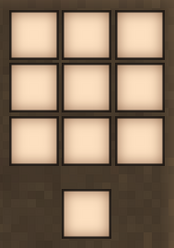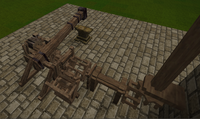Marteau à bascule
Le marteau à bascule est un outil destiné à marteler les loupes ferreuses sur une enclume lors des travaux de forge, mais aussi à fabriquer des plaques de métal.
Fabrication
Un marteau à bascule est composé du marteau en lui-même et de la structure en bois - la base de marteau à bascule et la came en bois. Accessoirement, un frein ou un couple composé d'une transmission et d'un embrayage peuvent être ajoutés pour arrêter le marteau à bascule si nécessaire.
Marteau à bascule
Les matériaux nécessaires pour la tête métallique de l'outil déterminent la méthode de fabrication requise :
Contrairement aux autres outils, le marteau à bascule n'éprouve pas d'usure, par conséquent, le matériau métallique utilisé pour la tête n'a aucun effet sur le travail de forge. Les métaux utilisables pour la tête du marteau à bascule sont les suivants :
| Matériau |
|---|
| Bronze-étain |
| Bronze-bismuth |
| Bronze noir |
| Fer |
Une fois la tête fabriquée, le marteau à bascule doit être assemblé dans la grille d'artisanat :
| Ingrédients | Recette |
|---|---|
| Tête de marteau à bascule 8x Planches |
Base et Came du marteau à bascule
La base supporte le marteau à bascule proprement dit, tandis que la came connecte le bras du marteau à la transmission de puissance.
| Ingrédients | Recette |
|---|---|
| Base : Marteau Ciseau 3x Planches Résine |
| Ingrédients | Recette |
|---|---|
| Came : Marteau Ciseau 8x Planches Axe en bois 4x Résine Graisse |
Frein, transmission & embrayage (optionnel)
Un frein peut être utilisé pour arrêter l'intégralité de la chaîne de transmission de puissance. À la différence d'une transmission, qui coupe temporairement l'alimentation en puissance, ou qui sépare la chaine de transmission de puissance en deux. Pour utiliser une transmission, un embrayage doit également lui être accolé, fonctionnant de la même manière que le frein.
| Ingrédients | Recette |
|---|---|
| Frein : Marteau Ciseau Bûche Axe en bois 2x Résine |
| Ingrédients | Recette |
|---|---|
| Transmission : Marteau Scie Ciseau 8x Planches 2x Engrenage angulaire 2x Résine Graisse |
| Ingrédients | Recette |
|---|---|
| Embrayage : Marteau Scie Ciseau 8x Planches 8x Bâtons Bûche 2x Résine 2x Graisse |
Utilisation
Voir aussi Puissance mécanique
Le marteau à bascule pour automatiser certains travaux de forgeage comme le traitement des loupes ferreuses et la fabrication de plaques métalliques. Toutefois il ne peut être utilisé que pour ces deux actions, et ne peut pas fabriquer d'outils ou d'autres articles forgés. Ils peuvent par contre être utiles pour récupérer les voxels manquants sur une loupe ferreuse, suite à une mauvaise manipulation à l'enclume.
Utilisation manuelle
The helve hammer cannot be used without mechanical power, nor can it substitute for the hammer in grid crafting.
Automated Operation
Helve hammers require mechanical power to run properly, and can be quite taxing for the power setup. For more info on power generation & power trains, see mechanical power. With a full complement of sails, the helve hammer will function, albeit slowly, at wind speeds as low as 30%.
- Power Input: The helve hammer must be powered by connecting the incoming axle on the left or right of the toggle and cannot be powered by connecting the axle to the top or bottom of the machine.
- The helve hammer base should be placed with the long arm of the triangular support and crossbeam facing the direction the player intends to place the hammer. The sloped sides of the base are the back of the block, and the helve hammer will further place directionally. An anvil needs to be placed three blocks away from the base in the same direction, so be sure to have enough free space in front the base.
- The toggle must be placed adjacent to the helve hammer base, at the upward sloping side towards the anvil. The toggle places sideways, be sure to orient the toggle such that the square frames continue the frame of the helve hammer base. The input axle cannot be placed on the frameless sides of this block.
- Then add the helve hammer itself onto the base. When placed correctly, the helve hammer will snap with the toggle and should rest on the anvil when not in use. When placed on the base, the helve hammer requires two blocks to move freely through its arc.
- The brake (optional) can be placed on the opposite side of the axle leading into the base. It can be used to completely stop the whole power train the helve hammer is connected to.
- A transmission and clutch setup (optional) can be used as a temporary brake or to separate the helve hammer from the rest of the power train. The transmission needs to be placed between the helve hammer toggle and the power input, functioning as an interrupted axle. The clutch can then be placed on its side - only when the clutch is engaged with a right click will the transmission actually transfer power. This setup is especially helpful when working with low power input or a complicated power train, as it allows to disengage the power-intensive helve hammer from the rest of the train if needed.
- Material Input: Blooms or ingots need to be placed by hand on top of an anvil placed under the helve hammer's head. They need to be heated to the appropriate temperature, just as if smithing by hand - however, with high wind power, the helve hammer will potentially take less time then manual smithing would.
- Material Output: Processed items will simply fall off the anvil after they are finished. Since there is no way to automate the Input, there is no profit in automating the Output, as is possible for instance for the quern.
Combat
While the helve hammer has a 3m range, it has no attack power stat and can therefore not be used in combat.
Storage
Unlike other tools, the helve hammer cannot be placed on a tool rack. Helve hammers do not stack in inventory or when placed in containers.
See also
Gallery
| Minerais, métaux et minéraux | |
|---|---|
| Guides | Gisements de minerais • Métaux |
| Métaux | Cuivre • Fer • Fer météorique • Or • Argent • Plomb • Étain • Zinc • Bismuth • Titane • Nickel |
| Alliages | Bronze (bronze-étain, bronze-bismuth, bronze noir) • Acier • Laiton • Soudure (soudure au plomb, soudure à l'argent) • Cuproplomb • Cupronickel • Électrum |
| Minéraux | Alun • Borax • Cinabre • Charbon • Halite (sel) • Lapis-lazuli • Quartz • Salpêtre • Soufre • Sylvine (potasse) |
| Outils | Pioche • Marteau • Pioche de prospecteur • Creuset • Forge • Bombe d'extraction de minerai • Meule • Enclume • Bas fourneau • Marteau à bascule • Pulvérisateur |
| Autre | Gemmes |
| Mécanique associée | Orpaillage • Minage • Modelage d'argile • Fonderie • Forge • Fabrication de l'acier |
| Wiki Navigation | |
|---|---|
| Vintage Story | Guides • Foire aux questions (FAQ) • Vintage Story Original Soundtrack • Versions • Controls |
| Systèmes de jeu | Artisanat • Taille de pierre • Modelage d'argile • Forge • Cuisine • Température • Faim • Minage • Stabilité temporelle • Puissance mécanique • Commerce • Agriculture • Élevage |
| Le Monde | Création du monde • Biomes • Météo • Tempêtes temporelles |
| Objets | Outils • Armes • Armure • Vêtements • Sacs • Matériau • Nourriture |
| Blocs | Terrain • Plantes • Décoratifs • Éclairage • Fonctionnels • Minerai |
| Créatures | Entités hostiles • Animaux • PNJs • Joueurs |
| Miscellaneous | Liste des commandes client • Liste des commandes serveur • Creative Starter Guide • Bot System • How_to_use_WorldEdit • Caméra cinématique • Enregistrement de vidéos à taux variable • ServerBlockTicking |

